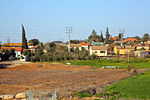Gath (city)

Gath or Gat (Hebrew: גַּת, romanized: Gaṯ, lit. 'wine press'; Latin: Geth, Philistine: 𐤂𐤕 *Gīt) was one of the five cities of the Philistine pentapolis during the Iron Age. It was located in northeastern Philistia, close to the border with Judah. Gath is often mentioned in the Hebrew Bible and its existence is confirmed by Egyptian inscriptions. Already of significance during the Bronze Age, the city is believed to be mentioned in the El-Amarna letters as Gimti/Gintu, ruled by the two Shuwardata and 'Abdi-Ashtarti. Another Gath, known as Ginti-kirmil (Gath of Carmel) also appears in the Amarna letters. The site most favored as the location of Gath is the archaeological mound or tell known as Tell es-Safi in Arabic and Tel Zafit in Hebrew (sometimes written Tel Tzafit), located inside Tel Zafit National Park, but a stone inscription disclosing the name of the city has yet to be discovered. Archaeologists believe it was the largest city of the Southern Levant during the 10th and 9th centuries BCE. Recent excavations have uncovered dramatic evidence of a siege and subsequent destruction of the site in the late 9th century BCE, which can be related to the biblical verse that mentions its capture by Hazael of Aram Damascus. A Gittite is a person from Gath.
Excerpt from the Wikipedia article Gath (city) (License: CC BY-SA 3.0, Authors, Images).Gath (city)
3832, Yoav Regional Council
Geographical coordinates (GPS) Address Nearby Places Show on map
Geographical coordinates (GPS)
| Latitude | Longitude |
|---|---|
| N 31.7 ° | E 34.847 ° |
Address
3832
Yoav Regional Council
South District, Israel
Open on Google Maps











